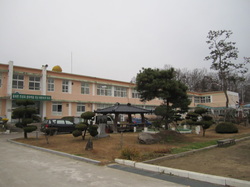 Last week after providing an update about my elementary school's Flat Stanley project I happened to look at the statistics for this blog and was surprised to see that 70 different people visited the blog that day. I was a bit taken aback because I assumed the only people checking the blog were my parents, a few siblings and other relations as well as a handful of friends. So, in my mind I've been writing for a total of maybe 20 people who are already somewhat familiar with my adventures because they had heard about them directly from me or through the family grapevine. After the surprise wore off I realized many of you don't know I teach at three schools nor any of the other details with which I took for granted you already knew. In order to rectify this I will introduce my different schools over the next week or so.
Since I've already mentioned my elementary school I thought I'd start there. I teach at a small rural elementary school once a week. It's a few kilometers outside of Jeomchon so each morning a teacher picks me up and every afternoon a different teacher drops me off at my apartment. The elementary school is so small that my average class size is seven. Yes, you read that right - 7. I teach 3rd, 4th, 5th and 6th grades. As I mentioned in my previous post a few of my students are near native English speakers. From what I understand their parents are somehow associated with the recent construction of an English medium private Christian middle and high school across the street. When they reach 6th grade they will transfer to the private school but for now I am responsible for teaching them English. It is one of the most challenging aspects of my job at this school because while half the class struggles with "this is a pencil" these students are far beyond that point and they should be studying English grammar in order to improve their written English. For now, I ask them to write journal entries so they can at least practice writing English at a higher level. At this school I teach 6 classes a day - teaching just one class to the 3rd and 4th grade classes before teaching English twice to 5th and 6th graders. Overall my classes are well-behaved although the 5th grade class is a bit noisy are as any class with 6 rowdy little boys. Though there are many aspects which are similar between US and Korean elementary schools there are also numerous differences. When you first enter the school you come upon cabinets filled with shoes. You are required to remove your shoes and wear indoor shoes. This didn't surprise me all that much, in fact I brought a pair of shoes for exactly this occasion because it's pretty standard in Japan and I assumed there would be a similar cultural norm in Korea. Here, things appear to be a bit lenient regarding the indoor/outdoor shoe policy and teachers (and students) will wander outside around the school yard wearing their indoor shoes before heading back into the building.
0 Comments
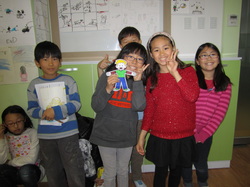 For those of you who don't know already, I teach at 3 schools here in Korea. My base school is a technical high school where I am at 3 days a week. I also visit an elementary school and academic high school one day each a week. At the elementary school I teach small classes of very energetic 3rd, 4th, 5th and 6th graders. My elementary school is an unique situation because 6 of my 28 students already speak English - most lived in the USA or New Zealand and one girl attended an English medium Christian school here in Korea. This presented me with a bit of a challenge - the lessons in the book are too easy for these native or near native English speaking students while their classmates are at a lower language comprehension level and are understandably shy in class. I am also required to use a textbook in each class which makes things a bit more complicated because all the directions are in Korean and the English is, at times, awkward at best for a native speaker. Thankfully I am permitted to detour from the books on occasion and so I decided to do the Flat Stanley project with my students. If you're not familiar with Flat Stanley click here to read a little background.
In class last week we briefly reviewed the story of Stanley Lambchop and the Flat Stanley project and before each student wrote a letter to a host family for Stanley (gracious friends and family who volunteered to help out) and then colored his or her own paper doll. Though I'm not quite sure if all the students understand that their Stanley dolls will return to Korea with pictures and a letter of his/her adventure I think they will be excited to see all the places Stanley has visited and realize that they can communicate in English. Click here or on the Flat Stanley tab above to see pictures from our project. I'll update the page as we receive letters back and will upload a map showing all the places around the world Stanley visited. 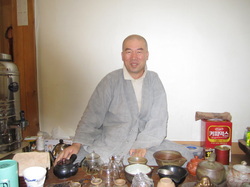 As I shared in my previous post I visited Hahoe Maeul last weekend. While there Youl and I wandered around the village for a few hours curious how people balance their modern lives in the traditional village. After we watched a folk dance performance on the outskirts of the village we went in search of a small shrine for the local guardian deity. We set off away from the crowds down an empty dirt road which led us to a hill atop of which sat a series of tile roofed buildings. Upon our approach at the bottom of the hill a dog began frantically barking and we hesitated unsure if we should continue however a friendly voice called down to us in Korean telling us that it was ok to proceed.
At the top of the hill we encountered an older woman and a man and through hand gestures, random English words and Youl's Korean we gathered that it was a Buddhist temple. The monk invited us to join him for tea and we followed him to a one story wooden building and slipped off our shoes before entering through the sliding door. The plain room was sparsely decorated with a low table, a variety of teapots and cups and a small altar to Buddha hanging above everything in a corner. The monk offered us a seat across from him on floor cushions and he began to prepare the tea. He poured hot water into a bowl, allowing it to cool slightly while spooning out tea leaves into a glass teapot. Once he was satisfied with the temperature of the water he poured it over the tea leaves and allowed it to sit briefly before dispensing it into small glass cups from which we drunk. Our time there was spent quietly observing our surroundings with the occasional attempt at discourse, though conversation was limited by the language difference. After numerous cups of tea we bid our farewell so we could catch the bus back home and the monk graciously invited us to visit him again. It was a delightful end to a very enjoyable day. 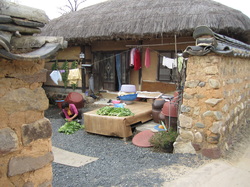 This weekend a friend and I decided to meet up and visit a UNESCO world heritage site outside of a city near Jeomchon. Andong Hahoe Village (안동하회마을) is a small village outside of the city of Andong, a place which promotes itself as "the spirit of Korea". I suspect that bold claim is at least in part due to Hahoe village. This small rural village consists of a series of Joseon era (16th century) traditional style buildings, including wooden artistocratic houses with tile roofs along side mud buildings with thatched roofs . Unlike many other tourist villages throughout Korea, Hahoe village is a living village where descendants of the Yu clan still reside in the houses their ancestors built. The Korean government subsidizes the village so that the locals maintain the traditional buildings and way of life. This does not mean that the village is void of modern conveniences as you will see electric lines leading into current homes and cars parked in large courtyards. The balance between village and tourist attraction is delicate - while locals go about their daily business, tourists wander throughout the village, peaking into courtyards, unsure where the public domain ends and private residence begins. Residents of Hahoe maintain more than just the traditional homes of the village, they also continue folk art traditions local to the region. On the outskirts of the village is a small open theater in which a mask wearing performance group act out a folk story which honors local spirits. This masked dance is the basis for Andong's annual mask festival which I attended in October. After wandering throughout the village for a few hours, my friend and I began to depart the village but the music from the masked dance caught our attention and we watched the performance for awhile. Upon inspecting the village map we realized a shrine to a local deity was near the theater and headed off to find it. Instead of finding the shrine we happened upon a Buddhist temple which will be the subject of my next post.  While November 11th is a slightly more somber holiday in the United States as we honor our veterans, the same date in Korea is along the lines of a mini-Valentine's day. Pepero (빼빼로), long slender biscuits coated in chocolate, are a popular snack here. Some of you might be familiar with pepero's inspiration - pocky, a Japanese treat. This holiday of sorts falls on today because 11/11 resembles 4 sticks of pepero. This year was advertised as "Millennium Pepero Day" because the date reads 11/11/11 and local stores were helping to build hype for the event.
Though I saw the display in the local Home Plus and heard a bit of chatter about it on facebook I didn't really give much thought to pepero day. That was, until I arrived at school. Boxes and wrappers of pepero cluttered some students' desks and in my first class a student handed me a box of strawberry pepero with a personal inscription wishing me a happy pepero day. During the remaining two classes throughout the day I had students slip me boxes of pepero during class as well as a few who waited in the halls afterwards to give me their homemade versions (my personal favorites). So now, at the end of the day I have a few boxes of pepero to snack on whenever I get the urge for something chocolatey (just when I finally got rid of all the Halloween candy!) and I have nearly a year to consider what I'll do for my students on the next pepero day. |
| Mindy in the City |
|












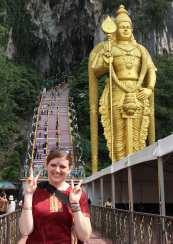
 RSS Feed
RSS Feed